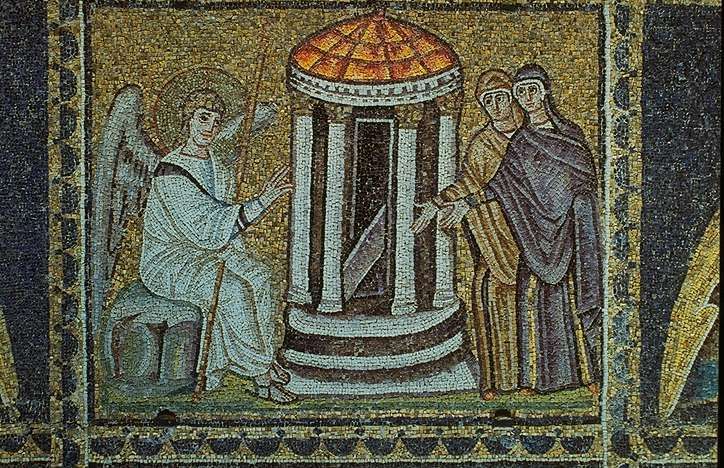
Site historique consacré à Marie, surnommée "la Magdaléenne" (alias Marie de Magdala, alias Marie-Madeleine)
4 Octobre 2019

Guercino (1629), The Risen Christ Appears to His Mother Mary
En Français

Cliquer ci-dessous
![]()
This is what Saint Ephrem the Syrian (d. 373), Father and Doctor of the Church (nicknamed “The Harp of the Holy Spirit”) wrote about the mother of Jesus:
“Mary hastened to replace the apostles to carry out the Lord’s orders. However, her role was not to give advice, to command, or to prevent the word of Jesus; so he reprimanded her, because she had acted with haste: My hour has not yet come (John 2:4); they will ask for wine, all will see that the wine is lacking, and then the miraculous sign will occur. Thus, when his mother saw him, after his victory over the underworld, she wished to embrace him as a mother [This is Mary Magdalene in John 20:17]. But Mary, who had followed him to the cross, had been entrusted to John that day by these words: Woman, behold your son; young man, behold, your mother (John 19:26-27). Also, after the resurrection, he prevented her from approaching him again, because, he says, since then John is your son.”[1]
Why did he prevent Mary from touching him? Perhaps because he had delivered her to John in his place: Woman, behold your Son (John 19:26). And yet not without her was the first sign [Cana], and not without her were the first fruits from Sheol. And so, even if she did not touch him, she was strengthened by him.”[2]
Saint Ephrem (306-373) is one of the many witnesses of the ancient Syriac tradition, now forgotten, but several centuries older than the Latin tradition (which made Mary Magdalene a prostitute). This ancient tradition makes no distinction between Mary nicknamed “the Magdalene” and the mother of Jesus.
[1] Éphrem de Nisibe, Commentaire de l’Évangile concordant ou Diatessaron 5, 5, traduction Louis Leloir, Paris, Cerf, 1966, p. 109.
[2] Éphrem de Nisibe, Commentaire de l’Évangile concordant ou Diatessaron 21, 27, traduction Louis Leloir, Paris, Cerf, 1966, p. 390 ; Robert Murray, Symbols of Church and Kingdom. A Study in Early Syriac Tradition, Cambridge, Cambridge University Press, 1975, p. 330.
See Also:
/image%2F2630383%2F20190928%2Fob_5c5927_christ-the-new-adam-b.jpg)
Jesus New Adam, Mary New Eve. Which Mary? - Marie appelée la Magdaléenne (Marie, Marie-Madeleine)
En F rançais Cliquer ci-dessous English version Link below Jesus the "New Adam", Mary The "New Eve" Which Mary? How can Mary, nicknamed "Megaddela" (i.e. "the Magnified One") be called "the ...
http://marie-la-magdaleenne.over-blog.com/2019/09/jesus-new-adam-mary-new-eve.which-mary.html
/image%2F2630383%2F20191030%2Fob_94941a_berthold-furtmeyr-eve-and-mary-missa.jpg)
Mary of Magdala: the "new Eve" - Marie appelée la Magdaléenne (Marie, Marie-Madeleine)
Recommended Book on Academia / Livre recommandé sur Academia Mary Magdalene The Unsuspected Truth (Part XIII) Berthold Furtmeyr, Tree of Life / Eve and Mary (Missal of Bernhard von Rohr, Archbishop
/image%2F2630383%2F20191024%2Fob_20c400_luc-1-46-47-1601.GIF)
Mary Magdalene and the Magnificat - Marie appelée la Magdaléenne (Marie, Marie-Madeleine)
Sandro Botticelli, Madonna del Magnificat (c. 1485) En F rançais Cliquer ci-dessous Sandro Botticelli, Madonna del Magnificat (c. 1485) Nous lisons en Luc 1, 39-57 : En ces jours-là, Marie partit et
http://marie-la-magdaleenne.over-blog.com/2019/10/mary-magdalene-and-the-magnificat.html
/image%2F2630383%2F20190612%2Fob_ead70b_l-ensevelissement-1285-png.PNG)
MARY OF MAGDALA = MARY MOTHER OF JESUS? - Marie appelée la Magdaléenne (Marie, Marie-Madeleine)
Mary Magdalene The Unsuspected Truth (Part IX) The Burial of Jesus, Livre d'Images de Madame Marie (1285-1290) En F rançais Cliquer ci-dessous Marie : la sainte Famille, détails (Agnolo Bronzino, c
/image%2F2630383%2F20190622%2Fob_6fa7da_duccio-di-buoninsegna-1308-1311.jpg)
Jesus and Mary: The Kiss - Marie appelée la Magdaléenne (Marie, Marie-Madeleine)
En F rançais Cliquer ci-dessous English version Link below Since the publication of the Da Vinci Code, the idea that Mary Magdalene may have been the sexual and/or mystical companion of Jesus has ...
http://marie-la-magdaleenne.over-blog.com/2019/06/jesus-and-mary-the-kiss.html
/image%2F2569100%2F20190309%2Fob_9e01cc_connaissance-hellenique.jpg)
Mary of Magdala: the mother of Jesus? - thierry-murcia-recherches-historico-bibliques.over-blog.com
English translation of an article published in french in: Connaissance hellénique , BILLETS, N°141 (July 2015) http://ch.hypotheses.org/1278 En F rançais Cliquer ci-dessous Article paru dans : ...